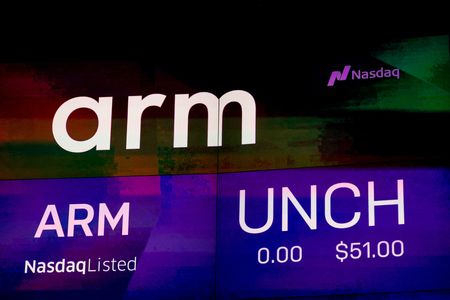By Stephen Nellis, Max A. Cherney and Arsheeya Bajwa
(Reuters) -Arm surged more than 30% on Wednesday after the British tech company forecast quarterly sales and profit above Wall Street expectations as customers aim to design new chips for artificial intelligence work, generating higher royalties.
The surge in Arm’s stock lifted its market capitalization by about $26 billion. Now trading at $102.11, Arm has doubled from the $51 price set in its September initial public offering.
The company, uniquely, supplies a library of blueprints to chipmaking rivals. Its majority owner SoftBank Group bet in 2016 that Arm could use its dominant position in smartphones, where it sits at the heart of both Apple and Android devices.
“The solid Arm earnings and, even more importantly, their robust forecasts are good signs for both the company and the tech industry overall,” said Bob O’Donnell, president and chief analyst at TECHnalysis Research.
Arm executives said on Wednesday the expansion strategy was starting to pay off, with customers flocking to Arm-based central processors to complement Nvidia’s chips for AI work in data centers, and working on new laptops and smartphones that can handle chatbots and other AI features.
The midpoints of Arm’s fourth-quarter sales and adjusted profit forecasts range of $875 million and 30 cents per share, respectively, beat estimates of $780.3 million and 21 cents per share, according to LSEG data.
It raised its guidance by roughly $100 million because markets such as automotive and AI are going to be strong in the fiscal fourth quarter, finance chief Jason Child told Reuters.
The company expects licensing revenue for chips that power AI in data centers, phones and PCs to be a significant factor.
Since 2016, Arm has significantly diversified its business.
Smartphones now represent 35% of overall units shipped, versus between 60% and 70% in 2016, Child said. He said as well that AI was driving additional sales, but mostly indirectly.
For instance, Arm-based central processors were frequently being paired with Nvidia’s graphics processors, or GPUs. More direct AI business, such as consumers buying new phones and laptops with special AI features, could take a year or more to play out, Child said.
“We’re seeing more interest in newer designs and newer technologies by customers” due to interest in AI, Child said. “It’s real. Folks are actually buying and licensing that technology.”
EVOLVED MODEL
Arm makes money two ways: via licensing deals for its intellectual property and a royalty charged for each chip sold that uses its technology.
In recent years, more of Arm’s customers have started using the ninth and newest version of its core chip architecture, which is important to Arm’s bottom line because the company charges about double the royalty rate per chip for the technology.
Child said about 15% of Arm’s royalty revenue is coming from its ninth-generation technology, up from 10% in the previous quarter.
“Investors are starting to appreciate … how Arm’s evolved business model is going to benefit from more advanced chip designs across the board in all markets,” said analyst Ben Bajarin from Creative Strategies.
For the full fiscal year, Arm expects $3.18 billion in revenue and adjusted earnings of $1.22 per share, both above analysts’ estimates of $3.05 billion and $1.07 per share.
For the fiscal third quarter, Arm reported sales of $824 million and adjusted earnings of 29 cents per share, topping Wall Street estimates of $761.6 million and 25 cents per share.
(Reporting by Stephen Nellis, Noel Randewich and Max Cherney in San Francisco and Arsheeya Bajwa in Bengaluru; Editing by Lisa Shumaker, Sayantani Ghosh and Chris Reese)

